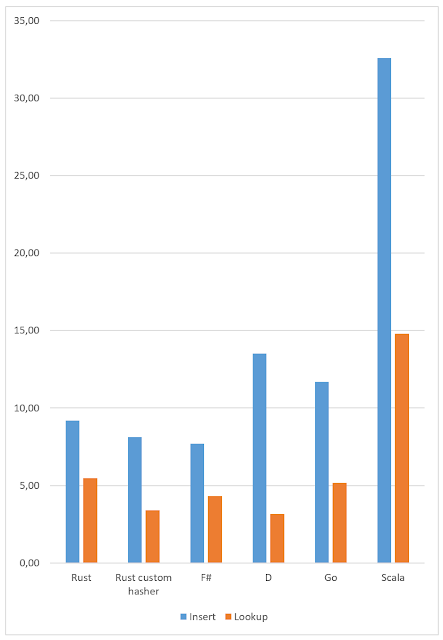Parallel reduce: Hopac, Asyncs, Tasks and Scala's Futures
We translate the original code almost as is to Tasks and Hopac:
And Scala's Futures:
The results (Core i5, 4 cores):
- Sequential List.reduce: Real: 00:00:00.014, CPU: 00:00:00.015, GC gen0: 0, gen1: 0, gen2: 0
- Tasks: Real: 00:00:01.790, CPU: 00:00:05.678, GC gen0: 36, gen1: 10, gen2: 1
- Hopac: Real: 00:00:00.514, CPU: 00:00:01.482, GC gen0: 27, gen1: 2, gen2: 1
- Asyncs: Real: 00:00:37.872, CPU: 00:01:48.405, GC gen0: 90, gen1: 29, gen2: 4
- Scala Futures: 4.8 seconds
Hopac is ~3.5 times faster than TPL. What's wrong with Asyncs? I don't know. Maybe they are not intended for highly concurrent scenarios. Or my code may not be the most efficient. Any ideas, guys?
Let's test the leaders on larger arrays:
(Hopac is 3.37 times faster, Scala is 1.5 times slower)
(Hopac is 5.25 times faster, Scala is 1.05 times slower)






Comments
For high-parallelism use e.g. Array.Parallel.
E.g. for array with just 5000 items:
Array.reduce (fun c -> fun x -> System.Threading.Thread.Sleep(30);x+c) a
Real: 00:02:36.232
reduceParallelTasks (fun c -> fun x -> System.Threading.Thread.Sleep(30);x+c) a
Real: 00:00:06.730
reduceParallelAsync (fun c -> fun x -> System.Threading.Thread.Sleep(30);x+c) a
Real: 00:00:05.361
reduceParallelHopac (fun c -> fun x -> System.Threading.Thread.Sleep(30);x+c) a
Real: 00:00:20.032